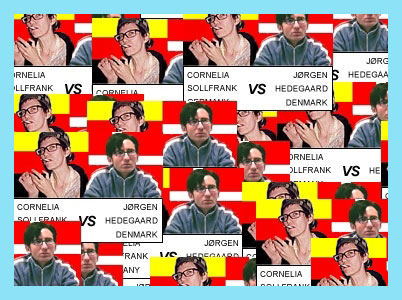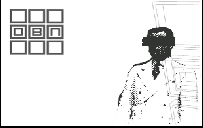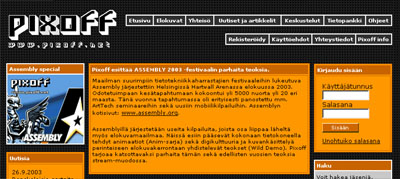|
|
 |
September
30th. 2003: NetArt for real |
 |
[September
30th. 2003]

NetArt for real
Jørgen Hedegaard and Cornelia Sollfrank talk.
Jørgen Hedegaard (Denmark) is the man
behind "FlatTV" www.FlatTV.dk,
Cornelia Sollfrank (Hamburg/Germany) is running "old
boys network" www.obn.org.
They both work on other projects as well. They share the opinion
that the internet's communicative potential (like; networking, integrating,
relating, broadcasting and communicating) is one of the future key
aspects in NetArt. Among other things, this was a topic for the
following discussion.
Jørgen Hedegaard (JH):
I'm so glad to talk to you again Cornalia, we meet in Kiel last year,
where you gave a lecture on "Hacking Art" at Muthesius Hochschule
fur Kunst und Gestaltung. You introduced your work "Female extension"
(see here: http://artwarez.org/femext/index.html),
and talked about Cyberfeminism and activism related to the internet.
It was a pleasure hearing about your use of the internet, as a communication
tool and space for artistic and activist interventions and innovations.


Old boys Network
and Flattv.dk
One of your subjects in the lecture was the question
"what is NetArt?". Where are you today, and what do you
do ?
Cornelia Sollfrank (CS):
Regarding the question what NetArt is, I would like to introduce a
distinction between net.art and NetArt.
The first one, with the dot, refers to a loose group of people that
came together for the first time in 1996. These cultural producers
(artists, activists and computer programmers) had met online through
the mailing list 'nettime' - http://www.nettime.org
- which is still around - and formed a context for art production.
They all came from different backgrounds and had different artistic
practices, that's why it is hard to generalize what their art was,
except that it mainly happened on the Net. These people however used
a smart marketing idea, called what they were doing 'net.art' and
promoted it all over. This labeling caused a lot of attention, and
in the end, what has started as a playful way to challenge the art
system, it's rules and representatives, became a serious 'business'.
It is also characteristic for 'net.art' to consider itself as pioneer
art on the Net. And most of it happened indeed before the big museums
and institutions got wind of it.
The second term, NetArt, is a very general expression for artistic
activities on the Net, which is not at all attached to certain names
or eras. Unlike some evangelists, I do not proclaim that NetArt is
dead; not at all. There is new people who do unexpected things at
unexpected levels of the Net which I would definitely call art. Why
should artists stop using this powerful tool and experiment with it?
The fact, that some artists started to cooperate with big institutions
and only produce new work when they get commissions maybe is a dead
end, but this is not all what is
happening.
JH:
OK then we have net.art from 1996-2000 as a marketing project, combined
with an anarchistic element of creating art spaces outside the institutions.
In that manner it was part of the "new economy" related
to the internet and giving powerless people the opportunity of defining
their own spaces to play in, and control it's content. This group
of people has dissolved (accounting to you), institutions absorbed
some, and others changed their field of work.
NetArt is the term for general art related activities on the internet.
Your definition of NetArt is an open door it seems, and I like that!
It's the only really honest and containing definition, because this
area is still developing very fast. Here in Denmark many people still
have the definition from the 90s, that NetArt only represents a minor
area of activity, which is strongly related to the projects made by
the group of people you refer to as the net.art group (the clan syndrome,
a part of aggressive marketing).
I think the bad situation here is also influenced by the fact that
our art schools are (very) poorly qualified in this area, therefore
some art history students and other "university people"
outside the real art community sets the pace, without much feedback
from "real" artists in the field.
I'm very pleased to observe NetArt moving into the time age of higher
bandwidth, it offers the possibility to really work with; video, sound,
and more complex flash-build artworks. Also the free source software
made in PHP (programming language) which enables people without too
much technical education (but just a bit of effort and patience) to
make dynamic networking projects and communities, seems interesting
to me.
What do you see as interesting on the scene today ?
CS:
I partly agree with you regarding the spread of audio and video works.
In fact, I feel the whole idea of net.radio is fantastic (net.tv probably
is still on the rise); the problem I have with these formats are,
that they depended for a long time on proprietary software and formats.
In the case of net.radio a lot has changed recently. There is a whole
lot of free software for streaming servers, sending and receiving
audio, and there is also a new standard for streaming audio (Ogg/Vorbis).
I think for any responsible and future-oriented work on the Net, one
has to be aware of the economic implications of what one is doing.
To answer your question: There are very different works which I like,
one example is Alvar Freude & Dragan Espenscheid from Stuttgart.
They have experimented with proxy-servers and manipulated the websites
of hundreds of people in order to demonstrate how easily content can
be manipulated without
any bad cracking and breaking into computers. (Information about:
"insert_coin": www.online-demonstration.org/insert_coin)
Another, completely different and very arty project is Thomson &
Craighead's "short films about flying" which generates on-the-fly
internet-based movies; it grabs moving pictures from airport webcams,
intersperses them with old-fashioned silent film inter-titles generated
from the net by a text-bot, and layers on top a soundtrack randomly
chosen from a digital radio station. This is very interesting for
me, because it works with the principle of automatic generation of
content (art). As you may know this is one of the basic artistic ideas,
which I am following with my net.art generators.
 Example from moi
Net.art generator by Cornelia Sollfrank
Example from moi
Net.art generator by Cornelia Sollfrank
And, last but not least, I have to recommend my new
net.art generators. Although the basic principle has stayed the same
over the years, the two new versions open new dimensions of automatically
generated content. http://soundwarez.org/generator/moiNAG/
JH:
The free formats for audio (and soon video, look here http://www.vorbis.com
) is really a good project, especially if the format gets integrated
into Windows Mediaplayer, which comes with Windows and Explorer. But
that's hardly going to be reality, because Microsoft has it's own
formats, and is running a business on them.
Microsoft controls 92% of all computers, because people like Windows.
The general user is not yet skilled to download and install a player
(or codec), therefore they use the formats installed by Windows. Today
+70% watches internet broadcasts in Windows Mediaplayer. I think one
has to look upon the positive sites of Windows, too. Their standards
make it possible to broadcast to people unskilled to install codecs
and do other technical things.
The project made by Alvar Freude & Dragan Espenscheid at the Academy
of fine arts in Stuttgart was fine. It's basically the same going
on in China today, here it's just the government controlling the server
between the internet and the user, blocking unwanted content before
it reaches the endures.
Yes I know about the random generator you made. Random generators
are very popular in NetArt, maybe because the computer can make "random"
easily, also the old computers could do that. For me "random"
is connected to the ideas developed in USA after the 2nd world war
in the 50ties and 60ties (art has to be un-personal, without personal/political
attitude/history +). For me most "random" projects are about
breaking down structures, and it sometimes ends up with just "random".
I feel like living in an age hungry for meaning and history, also
on a personal/ political level. Art must again take responsibility,
and get connected to personal and political reality.

From www.pixoff.net
Right now I'm looking at strange so-called armature
films at www.pixoff.net. They
all are in Finish, and some (absolutely not all) telling real fine
stories, it's not labeled "art", but maybe some of it is
art.
CS:
I would like to respond to your statement that artists should satisfy
the world's need for meaning and your reference to random art:
The artistic principle I am referring to with my generators is much
older than after the war, it is from the first and second decade of
the last century, and generally known as Dada. Although there have
no computers been involved, Dada artists have worked with the idea
of destroying meaning, of decontextualisation, of even refusing to
make 'art'. The surprising effect was, that what they were doing generated
meaning on a completely different and unexpected level. And what I
also like is the gesture of rejecting the expectations of society
or audience towards an artist. I don't want to be a priest, I do not
tell what is right or wrong, for me surprise and even frustration
are highly effective means to work with for an artist. If somebody
is looking for meaning, and I consciously frustrate this need, refuse
to provide anything to believe in or follow after, then the frustrated
person gets the opportunity to learn about his or her needs. It's
easy to catch people and give them what they want, but it is a hard
job to
frustrate and thus educate people.
I am basically fine with art you call 'personal' or has a 'political
attitude/history +'. But there is several aspects involved which I
would like to discuss, for example, authenticity has just become another
well-selling label in the art system. It raises the market value of
an artist. Second aspect, what is the actual social and political
impact of many of the works which are only produced to be shown in
the art context? These artists claim to have impact and influence
on the real world, but if you take a closer look it is as much 'l'art
pour l'art' as a 'beautiful painting'. Don't get me wrong, I guess
you know that I am a politically aware and critical person, what I
am trying to say is that the bringing together of art and politics
or art and social practice simply is much more complex and difficult
than just making a documentary video of a ralley (demonstration) or
an underrepresented or discriminated social group or run a workshop
for disadvantaged juveniles.
And doing so, does not produce any meaning to me, it just misses to
ask the right questions. That is what art could do for example.
JH:
OK, dada was earlier in deconstruction no doubt, but the meaning they
should have created on an unexpected level is unknown to me. The experiments
of the Dada movement only brought forward a context already there
I think. To make it clearer with a Dada experiment: If you take a
newspaper, cut up the lyrics with a scissor, and throw the paper-pieces
in the air, you will (maybe) find new suppressing sentences made randomly
after the paper-pieces has landed again. But this sentences was already
present in your brain, you just needed a push. I respect this mechanism,
and find it interesting, but not focused. I tried your generator,
using the words "schoolgirl" and later "schoolboy".
The generator produced a site with porn on the schoolgirl word, and
a site about football on the schoolboy word. I guess that's not too
surprising or new to me.
I don't think you go against the expectations of society and audience
doing things like that. Actually I think it would be much more of
a surprise if you acted as a preacher (as you said you wouldn't) having
some hand fest rules for the "audience" to obey. An authoritarian
role would be a real surprise, not some randomly search for new meaning
I think.
This brings me to your other argument. I agree there has been a quit
big marked made on "pseudo-humanist/political" issues. In
Denmark it was real big, especially in Copenhagen (town) some years
ago. People walked around using items/signals relating them to the
humanists and freedom fighters of the 70's. They made "events"
in exhibition rooms, and arranged demonstrations against racism ++.
It had no or very little effect on society I'm afraid. But however
the minor effect on the political situation here in Denmark, they
tried to make a difference, and I liked that (even though some projects
seemed a little overdone, maybe trying to qualify for the institution
ok ok).
I agree that art has a bigger potential, and I would like to see more
art dealing with the world outside the institution (and closed circle
of art-friends). That's the problem I think, art in an institutional
context, or art trying to qualify for the institution, just ends up
miming the context asked for (like people miming the youth ideals
(70 stuff) of an elderly museum manager or institution leader). It's
a closed cycle, and paralyses art efforts to some degree. I started
using the internet because it gave me the opportunity to work outside
the institution, and make my own context trough www.FlatTV.dk,
like being critical towards feminism for example. This project had
close to zero changes in the Danish institution at that time. That's
the cool thing about the Internet, it gives us back the autonomy and
control, leaving the institution behind :-).
Thanks for the talk Cornelia, and I hope to see you again soon, we
always have a good time loaded with critical discussions.
CS:
OK bye bye.
|
 |
|
|